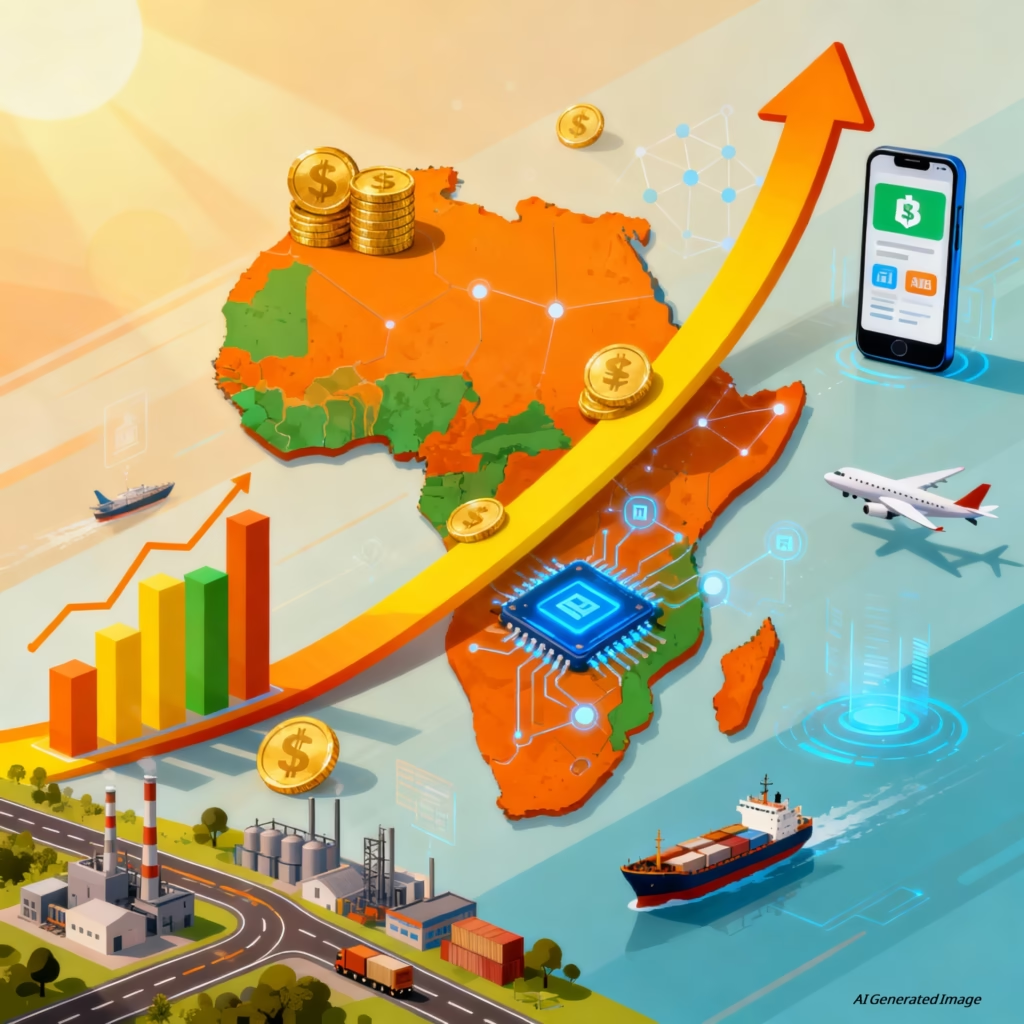How African Countries Can Overcome Financial Instability and Thrive in Global Development
Africa today stands at a critical crossroads between persistent challenges and extraordinary opportunities. Across vibrant cities and resilient rural communities, millions of Africans navigate daily hardships caused by inflation, currency instability, and limited access to finance. Yet beneath these struggles lies a continent brimming with innovation, entrepreneurial spirit, and transformative potential. From mobile banking revolutions that reach the remotest villages to ambitious trade agreements connecting 1.3 billion people, Africa is rewriting the narrative of development. This is not merely a story of overcoming adversity it’s about Africa’s emergence as a dynamic force in the global economy, pioneering solutions that could reshape how the world approaches financial inclusion and sustainable growth.
What Are the Main Causes of Financial Instability in African Countries?
Financial instability across Africa stems from a complex web of interconnected challenges that have persisted for decades. At the core lies an overwhelming dependence on commodity exports, leaving economies vulnerable to volatile global price fluctuations. When oil prices plummet or agricultural commodity markets crash, entire national budgets collapse, triggering currency crises and inflation spikes.
The debt burden has reached alarming proportions. African nations are projected to spend close to 30 percent of their revenue servicing debts in 2025, with 25 countries facing net interest payments exceeding 10 percent of revenue. This debt trap emerged from multiple sources: expensive commercial borrowing, unfavorable lending terms from international institutions, and a shift away from concessional financing. Countries like Zambia, Kenya, and Egypt collectively owe billions to the IMF, while facing interest rates as high as 6.59% significantly higher than rates offered to comparable economies in other regions.
Weak institutional frameworks compound these challenges. Many African countries lack robust debt management systems, transparent public financial management, and adequate revenue mobilization capacity. Tax administration remains inefficient, with high levels of informality eroding the tax base, excessive tax exemptions draining potential revenue, and illicit capital flows to tax havens bleeding billions annually. Political interference in economic policymaking, corruption, and inadequate regulatory oversight further undermine financial stability.
External shocks from global pandemics to geopolitical tensions hit African economies disproportionately hard due to limited fiscal buffers and shallow financial markets. The COVID-19 pandemic exposed these vulnerabilities, while climate change threatens to drag down GDP by 2-5 percent annually by 2030 in most African nations.
How Does Financial Instability Impact Everyday Lives and Development Progress?
The human cost of financial instability reverberates through every aspect of African society. When currencies depreciate sharply, as witnessed in Nigeria and Zimbabwe, families watch helplessly as their purchasing power evaporates overnight. The price of essential goods food, medicine, fuel skyrockets, pushing millions deeper into poverty and forcing painful choices between education, healthcare, and basic sustenance.
Job creation stalls when investors flee unstable economies, and small businesses collapse under the weight of unpredictable inflation and credit scarcity. Young Africans, comprising the continent’s largest demographic, face bleak employment prospects despite their energy and potential. Financial instability perpetuates generational poverty cycles, as families cannot access credit for education, agricultural inputs, or entrepreneurial ventures.
At the national level, governments trapped in debt servicing prioritize foreign creditors over citizens’ needs. The stark reality: 32 African countries allocate more resources to external debt repayment than to healthcare, while 25 nations prioritize debt over education. This means fewer teachers in classrooms, insufficient medical supplies in clinics, and crumbling infrastructure that impedes economic activity.
Development progress grinds to a halt. Countries cannot invest in climate resilience, renewable energy transitions, or digital infrastructure precisely the investments needed for long-term prosperity. The social contract between governments and citizens frays as public services deteriorate, fueling political instability and social unrest witnessed in Kenya, Nigeria, and other nations facing IMF-backed austerity measures.
Which African Countries Are Most Affected, and What Risks Do They Face?
Financial instability manifests most severely in countries facing compounded crises. Sudan, Ethiopia, and Zambia exemplify nations where conflict, political instability, and debt distress converge catastrophically. Zambia defaulted on its debt and required complex restructuring under the G20 Common Framework, revealing the challenges of coordinating diverse creditor groups including China, Western nations, and commercial lenders.
Resource-dependent economies like Angola and Nigeria face acute vulnerability to oil price volatility, experiencing sharp GDP contractions when commodity markets turn unfavorable. Their heavy reliance on single export commodities leaves them exposed to external shocks beyond their control.
The debt crisis has pushed several countries toward or into default. Chad, Ethiopia, and Zambia requested participation in the Common Framework for Debt Treatments, though implementation challenges have delayed relief. Egypt, Kenya, and Angola collectively owe over $15 billion to the IMF as of 2024, with debt service obligations consuming massive portions of government revenue.
Central African countries lag furthest behind in financial stability and regional integration. Inadequate infrastructure, weaker institutional capacity, and limited access to trade routes perpetuate their isolation from continental and global markets. The Democratic Republic of Congo, Burkina Faso, and similar nations face projected GDP damage exceeding 70 percent by 2100 under current climate trajectories, compounding their financial vulnerabilities.
These nations risk entering vicious cycles: debt distress limits investment in productive sectors, stunting growth and reducing revenue generation, which worsens debt sustainability and triggers further borrowing at punitive rates. Without decisive intervention, these economies face decades of stagnation and potential collapse.
What Global Development Trends Can Africa Leverage for Stability and Growth?
Despite daunting challenges, powerful global trends offer Africa unprecedented opportunities for transformation. The digital revolution sweeps across the continent at remarkable speed, with mobile phone penetration reaching 61 percent and creating platforms for financial inclusion that bypass traditional banking infrastructure. Africa now leads the world in mobile banking innovation, with Sub-Saharan Africa hosting nearly 50 percent of global mobile money accounts and processing $2.5 billion in daily transactions.
The African Continental Free Trade Area (AfCFTA) represents a game-changing initiative connecting 1.3 billion people across 54 countries with combined GDP of $3.4 trillion. Projections estimate AfCFTA could boost intra-African trade by 45 percent by 2045, adding $275.7 billion in cross-border trade value. This continental integration offers African nations the chance to diversify trade partners, strengthen regional value chains, and reduce dependence on volatile external markets.
Global momentum toward sustainable finance and climate investment creates opportunities for African countries to access green financing for renewable energy transitions. The rising influence of emerging economies through platforms like BRICS offers alternative partnerships beyond traditional Western-dominated institutions. BRICS expansion to include Egypt and Ethiopia signals growing South-South cooperation that could provide more favorable financing terms and development support.
Technological leapfrogging allows Africa to bypass outdated infrastructure, moving directly to cutting-edge solutions in sectors from energy to agriculture to financial services. The fintech boom demonstrates this potential, with African startups attracting billions in venture capital and creating innovative products tailored to local needs.
How Can Stronger Financial Systems and Access to Credit Improve Economic Resilience?
Robust financial systems form the backbone of economic resilience, enabling households and businesses to weather shocks, invest in productive activities, and build wealth over time. For African countries, strengthening financial infrastructure means transforming economies from cash-dependent to digitally-enabled, from informally-financed to formally-integrated.
Enhanced credit access empowers small and medium enterprises (SMEs) the engines of job creation and innovation across Africa. When entrepreneurs can secure affordable loans without prohibitive collateral requirements, they expand operations, hire workers, and contribute to economic diversification. Traditional banking often excludes the majority: only 54 percent of African adults hold bank accounts, leaving hundreds of millions financially marginalized.
Improved debt management frameworks protect countries from unsustainable borrowing while enabling strategic investments. Countries like Rwanda and Botswana demonstrate that comprehensive legal frameworks, transparent reporting, and clear debt management objectives can maintain fiscal sustainability even with borrowing for development. Effective institutions coordinate borrowing activities, assess debt sustainability, and ensure borrowed funds finance productive rather than consumptive expenditures.
Strengthened banking sector regulation prevents financial crises while promoting stability. Adequate capital requirements, prudent lending standards, and effective supervision shield economies from the devastating bank failures that can trigger systemic collapse. Central bank independence and credibility enhance monetary policy effectiveness, allowing authorities to control inflation and stabilize currencies.
What Role Do Fintech and Digital Financial Services Play in Financial Inclusion?
Africa’s fintech revolution stands as perhaps the continent’s most remarkable development success story of the past two decades. Digital financial services have accomplished what traditional banking could not: reaching the unbanked masses across vast, underserved territories.
The numbers tell an extraordinary tale. Mobile money adoption in Sub-Saharan Africa tripled from 12 percent in 2014 to 33 percent by 2021, narrowing the “digital gap” dramatically. Kenya’s M-Pesa pioneered this transformation, reducing the average distance to the nearest financial service point from 9.2 kilometers for banks to just 1.4 kilometers for mobile money agents. This accessibility revolution extended secure, reliable financial services to populations previously excluded by geography and poverty.
Mobile money transcends simple money transfers. It enables digital savings, facilitates bill payments, provides access to micro-credit, and supports agricultural supply chains. For women historically marginalized in formal finance mobile money offers confidential, safe saving instruments tailored to their needs, dramatically reducing gender financial inclusion gaps. In countries like Ghana and Uganda, mobile money has become the norm, with most adults actively using these services.
The fintech ecosystem continues evolving. Neobanks purely digital financial institutions with no physical branches—offer wider service ranges at lower costs through reduced overhead. They provide investment platforms, digital wallets, budgeting tools, and 24/7 customer service, competing effectively against traditional banks. Nigeria has emerged as Africa’s prime venture capital hub for fintech, with startups like Flutterwave raising record-breaking funding rounds exceeding $250 million.
Digital financial services drive economic formalization, bringing informal sector participants into the formal economy where they gain access to credit, insurance, and investment opportunities. This formalization strengthens tax bases, improves economic data, and enables better policymaking.
How Do Regional Integration and Trade Agreements Like AfCFTA Aid Economic Stability?
The African Continental Free Trade Area represents Africa’s boldest step toward economic integration and collective prosperity. By creating a single continental market, AfCFTA addresses the fragmentation that has long hindered African development and left individual countries vulnerable to external shocks.
Intra-African trade currently accounts for only a small fraction of total trade, far below other regions’ levels. AfCFTA aims to change this by eliminating tariffs on 90 percent of goods, liberalizing trade in services, and establishing continent-wide rules on investment, intellectual property, and competition. Manufacturing currently dominates intra-African trade at 46 percent, followed by food at 21 percent sectors where expanded regional markets could drive industrialization and value addition.
The projected economic impacts are substantial. Studies estimate AfCFTA could enhance export growth and real GDP growth significantly, with some countries like Ethiopia potentially seeing real GDP growth increases of 2.5 percent. The agreement promises to lift millions from poverty, create employment opportunities, and accelerate industrialization through regional value chains.
Beyond trade volumes, AfCFTA builds economic resilience by diversifying trade partnerships. Countries overly dependent on European or Chinese markets gain access to regional alternatives, buffering against external demand shocks. Regional integration facilitates technology transfer, knowledge sharing, and collective bargaining power in global negotiations.
Infrastructure development will accompany trade integration, requiring $22.4 billion in cumulative energy infrastructure investments between 2025 and 2040, with 80 percent directed toward renewables. This infrastructure push creates jobs while addressing energy deficits that constrain productivity.
However, realizing AfCFTA’s potential demands strategic investment, well-designed policies, and synchronized reforms across national, regional, and continental levels. Infrastructure gaps, non-tariff barriers, and weak customs systems require urgent attention.
How Can Debt Management and Fiscal Reforms Prevent Crises and Attract Investment?
Effective debt management and fiscal reforms separate financially stable nations from those trapped in crisis. African countries that have prospered Botswana, Rwanda, Mauritius share common characteristics: transparent public finance management, comprehensive debt management legal frameworks, and disciplined borrowing practices.
Successful debt management begins with clear legal frameworks establishing borrowing authority, defining roles and responsibilities, outlining debt management objectives, and mandating transparency. South Africa and The Gambia exemplify comprehensive approaches, integrating debt management provisions into Public Finance Management laws. Rwanda and Botswana demonstrate that strategic medium-term debt strategies, when regularly reviewed and implemented, maintain sustainability even amid borrowing for development.
Fiscal reforms must prioritize domestic resource mobilization (DRM) to reduce dependence on external borrowing and aid. This requires broadening tax bases by reducing exemptions and preferences, improving tax administration efficiency, combating illicit financial flows and transfer pricing abuses, and strengthening tax compliance through better taxpayer education. African countries lose over $4.1 billion annually due to discriminatory interest rate premiums and billions more to tax evasion and capital flight.
Transparency and accountability form the cornerstone of sound fiscal governance. Publishing debt management reports, borrowing plans, and budget information enables public oversight and investor confidence. Nigeria’s Debt Management Office publishes detailed quarterly reports, setting a standard for transparency.
Investor confidence depends on predictable policy environments, credible institutions, and manageable debt levels. Countries demonstrating fiscal discipline attract foreign direct investment at lower costs, as investors perceive reduced risks. Conversely, debt distress triggers capital flight, currency depreciation, and economic contraction.
What Lessons Can African Countries Learn from Successful Financial Stabilization Cases Worldwide?
Global experience offers valuable lessons for African nations navigating financial instability. Several pathways to stabilization emerge from historical cases across regions and development contexts.
First, macroeconomic stability requires political commitment to difficult reforms, even when facing public resistance. Countries that successfully stabilized debt ratios did so through fiscal consolidation combining spending discipline with enhanced revenue mobilization. This demands strong institutions insulated from political interference and consistent policy implementation over multiple years.
Second, diversification protects against commodity dependence volatility. Côte d’Ivoire’s climb up continental rankings reflects strategic shifts from exporting raw agricultural commodities to domestic processing, creating hundreds of thousands of jobs while adding value to cocoa and cashew production. Similarly, successful emerging markets built diverse export portfolios spanning manufacturing, services, and technology sectors.
Third, financial sector development strengthens monetary policy transmission and crisis resilience. Countries that deepened financial markets, enhanced banking sector regulation, and developed local currency debt markets gained greater policy autonomy and reduced vulnerability to external shocks. Mauritius exemplifies this approach, developing robust financial infrastructure that supports economic stability.
Fourth, regional cooperation amplifies individual countries’ stabilization efforts. The Southern African Development Community and East African Community demonstrate how coordinated monetary and fiscal policies, shared infrastructure projects, and integrated markets build collective resilience.
Fifth, strategic international partnerships matter. Rwanda’s engagement with diverse development partners, combined with strong domestic governance, enabled reconstruction and impressive growth trajectories. Balancing relationships with traditional donors, emerging partners like China and BRICS nations, and multilateral institutions provides flexibility and leverage.
How Can International Partnerships and Aid Be Optimized for Sustainable Development?
International partnerships play crucial yet controversial roles in African development. Traditional development assistance flows are declining net bilateral Official Development Assistance (ODA) to Africa fell from 2023 to 2024, with Sub-Saharan Africa facing projected declines in 2025 as major donors cut budgets. This reduction occurs precisely when African countries need support for climate adaptation, infrastructure, and social services.
Optimization requires fundamental reforms to international financial architecture. African nations advocate for greater representation in global governance institutions—the IMF, World Bank, and UN Security Council to ensure their interests shape global policies. Current structures perpetuate inequities, with African countries paying higher interest rates and facing stricter conditionalities than comparable borrowers elsewhere.
Debt relief initiatives must become more effective and comprehensive. The G20 Common Framework has relieved only 7 percent of debt owed by vulnerable countries, falling far short of needs. Economists propose limiting debt service to 10 percent of state revenue, which could provide clean water access to 10 million people and prevent 23,000 child deaths annually across 21 nations. Achieving this requires coordinating diverse creditors bilateral, multilateral, and private around sustainable solutions rather than temporary palliatives.
Alternative partnerships through BRICS and South-South cooperation offer more favorable terms and reduced conditionalities. The BRICS New Development Bank provides infrastructure financing in local currencies, reducing dollar exposure and offering alternatives to Western-dominated institutions. However, these partnerships require careful navigation to avoid new dependencies or unsustainable debt accumulation.
Climate finance represents a critical partnership opportunity. Africa requires $50-200 billion annually for climate adaptation depending on warming scenarios, yet current adaptation finance of $14.8 billion remains far below needs. International partners must deliver on climate commitments, recognizing that Africa contributed merely 1.9 percent of historical global emissions yet faces disproportionate climate impacts.
Conclusion – Actionable Insights
Africa’s journey from financial instability toward sustainable prosperity demands coordinated action across multiple fronts. For policymakers, priorities include strengthening institutional frameworks for debt management and public financial oversight, accelerating domestic resource mobilization through tax reforms and reduced exemptions, investing in digital financial infrastructure to expand inclusion, implementing AfCFTA protocols to unlock regional trade benefits, and building climate-resilient infrastructure funded through strategic partnerships.
Investors should recognize Africa’s tremendous potential amid challenges. The continent offers frontier markets with young populations, rapid digital adoption, and expanding consumer classes. Supporting fintech innovations, renewable energy projects, and regional manufacturing value chains promises both returns and development impact.
For entrepreneurs and citizens, engaging financial systems through digital platforms builds individual resilience while strengthening collective economic foundations. Participation in democratic oversight of public finances, advocacy for transparency, and support for regional integration initiatives empowers communities to hold leaders accountable.
The international community must reform global financial architecture to provide fairer access to development finance, implement comprehensive debt relief beyond current inadequate frameworks, deliver on climate finance commitments with grant-based rather than loan-heavy support, and respect African agency in development partnerships rather than imposing external priorities.
Africa’s financial stability and development success ultimately hinge on building robust domestic institutions, leveraging technological innovations like fintech and digital platforms, pursuing regional integration aggressively through AfCFTA implementation, diversifying economies away from commodity dependence, and forging strategic international partnerships on equitable terms.
The path forward is challenging but achievable. African nations have demonstrated resilience, innovation, and determination throughout history. By learning from successes, addressing institutional weaknesses, and harnessing global trends toward digitalization and regional integration, Africa can overcome financial instability and claim its rightful place as a driver of twenty-first century global prosperity.
For further exploration and engagement, readers can access authoritative resources through the International Monetary Fund Regional Economic Outlooks, African Development Bank Reports, World Bank Global Findex Database, United Nations Economic Commission for Africa, and participate in development dialogu
Keywords: financial instability Africa, economic development Africa, fintech Africa, financial inclusion, debt sustainability, AfCFTA, regional integration Africa, fiscal reforms, digital banking Africa, economic resilience, sustainable development Africa, mobile money Africa, debt management Africa, tax governance Africa, climate finance Africa, BRICS Africa partnership,
Disclaimer: Transparency is important to us! This blog post was generated with the help of an AI writing tool. Our team has carefully reviewed and fact-checked the content to ensure it meets our standards for accuracy and helpfulness. We believe in the power of AI to enhance content creation, but human oversight is essential.





